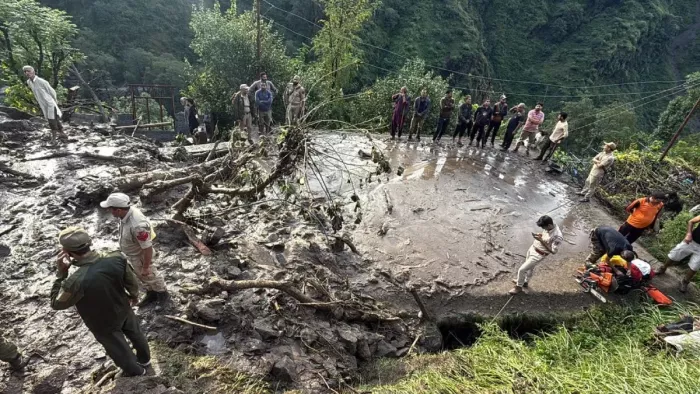Recent heavy rainfall and resulting landslides in North Bengal have wreaked havoc across Darjeeling, Mirik, and the Duars region. Reports indicate that over 30 individuals have lost their lives, including several children. In response to the escalating situation, authorities have issued a red alert for the Darjeeling and Kalimpong districts. The circumstances are expected to worsen further due to water being released from a hydropower dam in Bhutan. Chief Minister Mamata Banerjee has pledged compensation for the families affected by this devastating event.
Jagran Correspondent, Siliguri. Following a deluge in Kolkata, North Bengal faced its own catastrophic weather event. The torrential rains, which began late Saturday night, have caused significant destruction in large parts of Darjeeling, Mirik, and Duars. With over 300 mm of rain falling within just 12 hours, landslides became prevalent, homes were swept away, and rivers overflowed their banks. Currently, more than 30 fatalities have been confirmed, with numerous children among the victims.
In the Darjeeling district alone, 20 lives were lost, while five fatalities occurred in border villages along Nepal and Nagarakata in the Jalpaiguri district. The Meteorological Department has issued a red alert that will remain in effect until Monday for the Darjeeling and Kalimpong areas. Residents have been warned of the potential for further landslides due to the destabilization of soil in these mountainous regions.
Impact of Water Release from Bhutan
In a related development, Bhutan has begun releasing water from its hydropower dam, which is expected to exacerbate conditions in the Alipurduar, Cooch Behar, and Malda districts. National leaders including President Draupadi Murmu, Prime Minister Narendra Modi, Home Minister Amit Shah, and Defense Minister Rajnath Singh have expressed their condolences over the tragic events and offered their support to the grieving families.
Forecast for Deteriorating Conditions
As the situation unfolds, continuous rainfall persisted in Darjeeling, Mirik, and Kalimpong until late Sunday night. Reports indicate that Darjeeling received 261 mm of rainfall, Gajoldoba saw 302 mm, while Malbazar recorded 233 mm. Authorities are in the process of evacuating villages located along the Teesta River. With forecasts suggesting that conditions may worsen over the next 24 hours, residents are urged to remain vigilant.
The Disaster Management Department has cautioned that restoring road connectivity may take considerable time due to the ongoing landslides and heavy rains. The most severe impact was felt in the Mirik Block of Darjeeling, where 11 individuals lost their lives in landslides, and numerous homes have been buried under debris. Notably, the Siliguri-Mirik route has been completely disrupted following the collapse of the Dudhia Bridge.
Ongoing Rescue and Relief Efforts
Seven additional deaths have been reported in the Sukhiapokhari and Bijnabadi areas of Darjeeling sub-division, with many residents still unaccounted for. Teams from the National Disaster Response Force (NDRF), State Disaster Response Force (SDRF), the army, and local administrations are actively engaged in relief and rescue operations. North Bengal Development Minister Udayan Guha has stated that the situation remains critical and that while relief efforts are ongoing, continuous rain is posing significant challenges.
Successful Rescues Amidst Chaos
Richard Lepcha, the Sub-Divisional Officer (SDO) of Darjeeling, reported that many individuals have been rescued alive from the rubble thanks to the collaborative efforts of the NDRF and police. According to the NDRF, over 40 people have been successfully evacuated from the Dhargaon and Nagarakata areas. However, hundreds of tourists are currently trapped, with many from Kolkata and other districts stranded in Darjeeling, Ghoom, Lepachagat, and Mirik during the ongoing holiday period. Traffic has come to a standstill due to landslides affecting the Mirik-Sukhiapokhari Road and NH-10.
The North Bengal State Transport Corporation (NBSTC) has initiated special bus services to assist stranded tourists. In a tragic incident, five individuals drowned in the strong currents of the model village at Bamandanga tea garden in Nagarakata, including a two-month-old infant. The entire village was inundated due to over 325 mm of rainfall recorded in just five and a half hours, leading to the destruction of numerous bridges and roads.
Train Services Disrupted by Flooding
Additionally, ongoing rainfall toward Bhutan has caused the water levels of the Diana, Gathia, Sukhani Jhora, and Teesta rivers to surpass danger levels. The Bhutanese government has issued warnings regarding the release of water from its hydro dam, raising concerns about flooding risks in Alipurduar and neighboring regions. Consequently, multiple train services have been canceled due to flooding on the railway lines in Alipurduar, while some services have been rerouted.
Government Support for Victims
In light of the tragic events, Chief Minister Mamata Banerjee has announced government compensation for the families of the deceased and a promise of a government job for one member of each affected family. She emphasized that this disaster is a natural occurrence, urging tourists not to panic as the state government is committed to ensuring their safety and will manage their return home. She also advised hotel owners against imposing excessive fees during this challenging period.
Weather Conditions and Forecasts
According to Gopinath Raha, the director of the Meteorological Center in Gangtok, a deep depression formed in the Bay of Bengal on September 30. This system gradually moved in a north-northwest direction, reaching North Bengal within four to five days. As it traveled, it continued to gather moisture from monsoon winds and western currents, leading to the severe rainfall experienced in the region.
Upon nearing the Darjeeling and Jalpaiguri districts, the system resulted in intense rainfall due to the collision of weather patterns over the hills. The rising and cooling of air in the hilly areas led to the formation of clouds and significant downpours, culminating in the extreme weather event witnessed during the night of October 4. Meteorologists anticipate that this intense weather pattern may persist until October 6.
(With contributions from news agency PTI)















